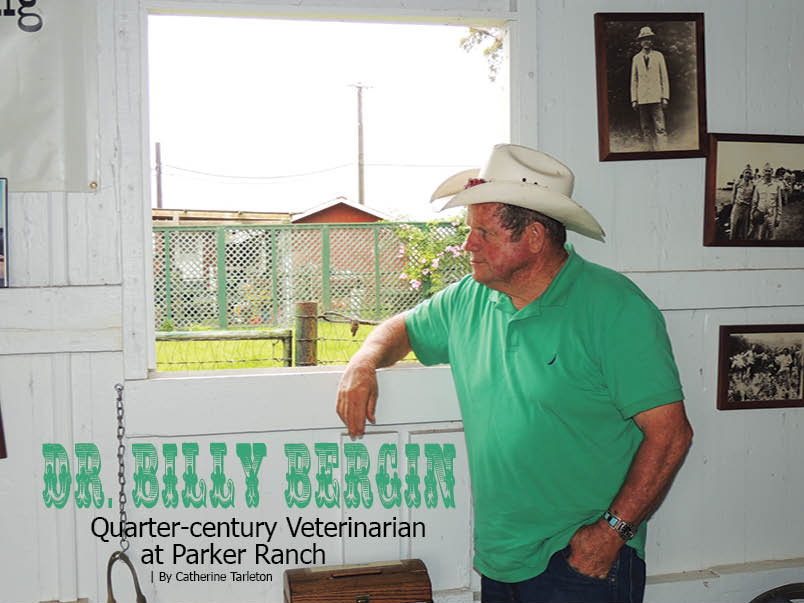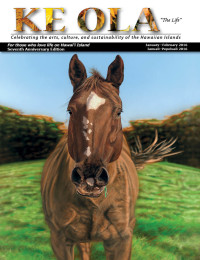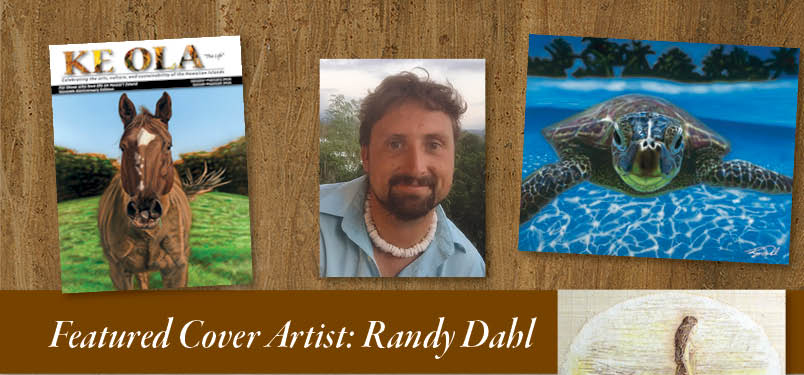
Dr. Billy Bergin: Quarter-Century Veterinarian at Parker Ranch
By Catherine Tarleton
On July 1, 1995, on the 25th anniversary to the day of coming, I left the Ranch,” said Dr. Billy Bergin, Parker Ranch’s quarter-century veterinarian and author of three books (soon to be four) about the venerable 160-year-old cattle operation. “As a parting gesture, management gave me a bound copy of my 25 years of annual reports that in itself, I realized, represented an historic document, albeit a mere glimpse of the great institution.”
The book contained 25 years of observation, 48 graphic measures of animal health—each animal scored by Dr. Bergin—a huge volume of data.
“Shortly thereafter, we took a cruise to Tahiti, and I took that bound copy,” says Billy. “I was thinking, I’m going to spend a few months and write the history of Parker Ranch. When we came home, I started to write the whole Parker Ranch picture from way back—750 AD. After two years, I had too much. I started Volume II and kept rolling forward until now I find I have to have a Volume IV.”
“In retrospect, it is Volume I that I cherish; I will never in my life do something that thorough ever,” he says.
Never dreaming he’d become a writer, much less author of four books with at least two more planned. Billy was a problem student in parochial school. Frustrated by his routine lack of attention, the nuns gave up on him by his third grade year.
At that point, Billyʻs father Bill Bergin, a physician on the Hāmākua coast, made the decision to take a friend up on an offer made years earlier.
Bill was the only son of an Irish immigrant, who came to Honolulu in 1888. He ran a saloon with rooms for let—the Waikiki Inn—populated by half a dozen retired bachelor Irish seamen.
“Bill Bergin was their boy,” says Billy. “And those six men put him through St. Louis College on River Street in Honolulu and then sent him to medical school in Omaha.”
“I went with him to Honolulu when I graduated from high school and we went to Nu‘uanu Cemetery where my grandfather was buried,” says Billy. “He said a few Ave Marias before several headstones with names I never recognized beyond my grandfather’s. I asked him if they were family, and he said, ‘No, and when you go home, look in the cabinet at my baby cup with six names.’ ”

There inscribed were the names of his benefactors.
Billy then queried his dad about being granted the privilege of po‘olua —a child raised by two father figures, when Uncle Holi joined in raising this little boy from Laupāhoehoe.
Before young Billy was born, Dr. Bill essentially saved the life of Mrs. Esther Ako Mae, wife of John Holi Mae of Kukaiau Ranch near Laupāhoehoe. She had suffered a ruptured tubal pregnancy and was hospitalized for about three weeks. When husband John came to bring her home from the hospital, Bill walked them out to the car.
“He told my father, ‘If you ever have a son, I would like to partake in his upbringing,’” says Billy. At age nine, Father allowed young Billy to go and live on the Ranch with Holi and his family. From then on, Billy was po‘olua—a son of two fathers.
“Look how that changed my whole life,” says Billy. “Estherʻs mother lived with us; she spoke no English. I was only nine, but I got it. Cowboy language is Hawaiian language. You go to other ranches, you adopt the language and other nuances.”
Billy grew up immersed in the deep-rooted, hardworking tradition of Hawaiian paniolo culture. And there, in the seclusion of nature, he was isolated and finally able to focus and to learn—defying all the dire predictions of the school nuns.
“How kind and thoughtful of him to do it,” says Billy. “Many years later he did another thoughtful thing.”
By age 12, Billy could shoe his own horse string and earned $100 a month in the summers and holidays at Pu‘u ‘Ō‘ō Ranch, owned by the Shipman’s. From there, he graduated to working at other smaller ranches all around the island—Keauhou, Kapāpala, Ka‘alu‘alu, Pu‘uwa‘awa‘a and Parker Ranch before leaving for college in Kansas.
“Some of the most dramatic, bizarre, tragic, memorable instances happened on these small ranches,’ says Billy.
“It’s about wonderful people: everyday, quiet, productive people—loyal, hardworking.”
At the end of his junior year in high school, he went to work at Parker Ranch for the first time. “By then I wanted to be a veterinarian,” Billy says. He attended Kansas State University, and found himself struggling in school again, eking out a 1.8 grade point average while sweating through general chemistry and college algebra. He had already started seeing Pat, former Miss Aloha Hawai‘i, who was attending University of Hawai‘i at Hilo on the pageant’s two-year scholarship.
“When I was starting to apply to veterinary schools, Dad said, ‘If it’s anything like medical school, you need a B+.’ ” Then he did the second thoughtful thing that his son has always remembered.
“He wrote me a note to stop in Los Angeles on my way home for the summer of 1962, as he was on his way to a conference in Lake Placid, New York,” says Billy. With three sisters there, the family could get together for a mini reunion. “Dad sat me down and said, ‘I think you should marry Pat sooner than later.’”
His reasoning was that, since Pat’s scholarship was running out, if she married Billy she could benefit from his Grandmother’s trust and be educated as one of the Bergin children. Overcoming some concerns from mother, Emma, who was already fond of Pat, the two married, and Pat went on to complete college at Kansas State.
“How remarkable, how unusual that was for my father to tell me to get married, how lucky. Of course, marrying Pat would have a settling effect which readily converted to good study habits.”
In veterinary school, it all came together for Billy, then an honor student. He says in some ways the professors had the ability to pick up where Esther left off years before, and his concentration was enhanced by Pat. Coming home, he began his quarter-century career with Parker Ranch in 1970 that inspired the Loyal to the Land book series.
“Loyal to the Land says something about the outfit,” says Billy in a video interview with the National Cowboy Museum. “If you are born and raised there, or worked on it, you never stopped loving the Ranch. You remain loyal to that outfit no matter what.”
Billy’s history book of Parker Ranch begins in 750 AD, when the highly prized green lands were farmed in taro, sweet potatoes and other food crops. Cattle arrived more than 1,000 years later, a gift of British Captain George Vancouver in 1788, to King Kamehameha I, who made them kapu and released them into the countryside. A short 20 years later, the wild “pipi” overran the landscape, wreaking havoc on native plants and people’s farms and homesteads.
John Palmer Parker was given the King’s permission to harvest the cattle and to establish trade in hides and salt beef. He married Kamehameha’s granddaughter, Chiefess Kipikane, and was awarded lands that eventually grew into Parker Ranch, having at one time over 500,000 acres and 50,000 head of cattle.
Elementally entwined with Hawaiian history, deeply committed to sustaining the land that inspires such loyalty for 160 years, the Ranch’s story is far-reaching and continues to expand. From seasons of growth and bounty, through times of war and hardship, the inevitable and difficult changes as the last Parker family heir passed away, and today’s refocus and renewed energy—the story continues. It continues to be the story of people, the hardworking paniolo families that have come, and gone, and remain.
Only Dr. Billy Bergin could tell those stories with the heart and soul they all share. Of Volume IV, covering the last 20 years, he says, “You gotta give me a happy ending to this book.” ❖
Contact Dr Billy Bergin
Contact writer and photographer Catherine Tarleton



